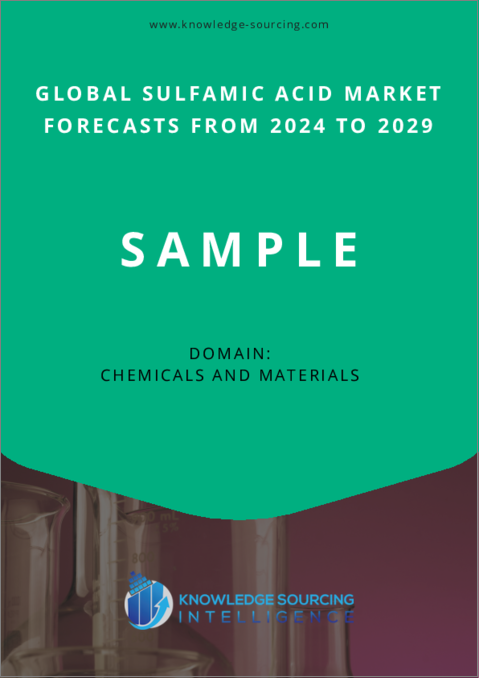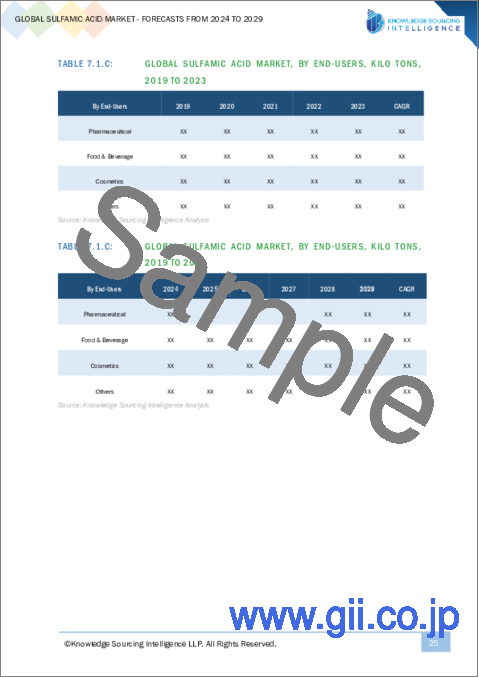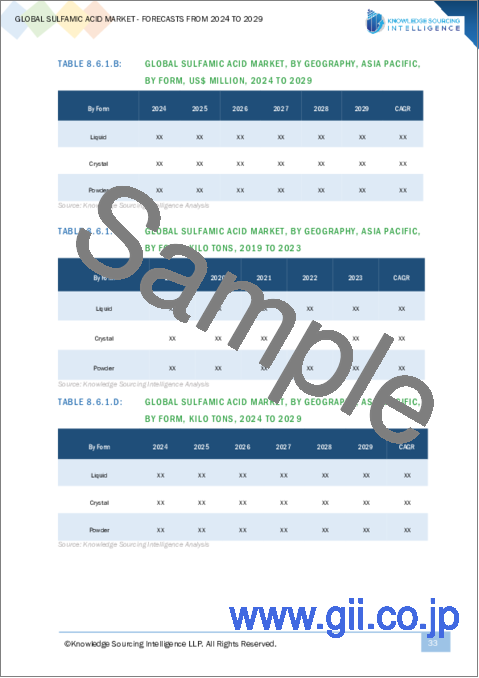|
|
市場調査レポート
商品コード
1295403
スルファミン酸市場-2023年から2028年までの予測Sulfamic Acid Market - Forecasts from 2023 to 2028 |
||||||
カスタマイズ可能
|
|||||||
| スルファミン酸市場-2023年から2028年までの予測 |
|
出版日: 2023年06月08日
発行: Knowledge Sourcing Intelligence
ページ情報: 英文 129 Pages
納期: 即日から翌営業日
|
- 全表示
- 概要
- 目次
スルファミン酸の世界市場は、CAGR 5.93%で成長し、2021年の2億7,259万3,000米ドルから2028年には4億2,446万2,000米ドルに達すると推定されています。スルファミン酸は、洗浄剤、水処理、染料・顔料、医薬品、工業用途など様々な産業で使用される汎用性の高い化学化合物です。化学式H3NSO3を持つ元素がスルファミン酸です。これらの名称とともに、アミノスルホン酸、アミノスルホン酸、アミド硫酸、スルファミド酸などと呼ばれることもあります。
急速な工業化、都市化、インフラ開発プロジェクトにより、スケール除去剤、金属洗浄、医薬品製造など、さまざまな用途でスルファミン酸に対する大きなニーズが生まれています。スルファミン酸市場シェア拡大の主な理由は、様々な産業用途への高い需要と、パーソナルケア商品への業界ニーズの高まりです。パーソナルケア製品市場は、スルファミン酸市場を活性化させると予想されています。例えば、Vishnupriya ChemicalsというISO認証を持つインドの企業は、塩素の安定化に使用される腐食防止剤に代わるテクニカルグレードのスルファミン酸を定期的に生産しています。
促進要因
政府規制。
スルファミン酸の使用を規制する政府規制の拡大が、市場の成長を後押しすると予想されます。例えば、欧州化学物質庁(ECHA)は、化学物質の登録・評価・認可・制限(REACH)規則においてスルファミン酸を有害物質として分類しています。これにより、多くの最終用途産業においてスルファミン酸の使用に関する規制が強化され、環境に配慮したスルファミン酸の需要が高まることが予想されます。
さらに、スルファミン酸の製造、使用、廃棄はすべて中国環境保護部による規制と監視の対象となっています。日本の経済産業省は、スルファミン酸の製造、使用、廃棄に関して、公共の安全を守り、環境保全を進めるために、様々なガイドラインを作成しています。
紙・パルプ需要の拡大
紙・パルプ業界では、スルファミン酸を漂白剤やパルプ脱リグニン剤として使用しています。スルファミン酸の売上は、新興国における紙および紙製品の需要増加により増加すると予測されています。デジタル化傾向の拡大により、紙ベースのパッケージの需要が高まり、紙・パルプ分野でのスルファミン酸のニーズが高まっています。
製薬業界への応用。
スルファミン酸は様々な用途に使用されるため、製薬業界でも注目されています。抗ウイルス剤や抗がん剤など、いくつかの医薬品分子の製造において、スルファミン酸は原料としての役割を果たしています。また、スルファミン酸は、医薬活性成分の制御された標的放出を可能にする薬物送達方法としての可能性も研究されています。さらに、抗生物質、ヌクレオシド/ヌクレオチド系HIVプロテアーゼ阻害剤(PI)、ステロイドスルファターゼ阻害剤および炭酸脱水酵素阻害剤、抗てんかん薬、HIV逆転写酵素阻害剤など、あらゆる種類の治療薬がスルファミン酸塩を利用して作られています。
さらに、動物にもさまざまな病気に対するケアや保護が必要であり、農家や動物の人口増加に伴い、動物用の医薬品が必要とされています。最近では、タイのAnimal Supplement & Pharmaceutical Co.Ltd.が、スルファミン酸を活用して、細菌、真菌、その他のさまざまな生物から家畜を守る消毒剤OXIPROを発売しました。
アジア太平洋地域が2021年に大きな市場シェアを占めました。
スルファミン酸の世界市場を地域別に見ると、北米、南米、欧州、中東・アフリカ、アジア太平洋に区分されます。定評のある飲食品部門とアミノの新製品発売が、この地域の市場成長を牽引しています。国別では、アジア太平洋地域のスルファミン酸市場は、中国、インド、日本、韓国、インドネシア、タイ、台湾、その他に分けられ、中国が大きな市場シェアを占めると予測されています。
中国が製造インフラを整備した結果、新興諸国はスルファミン酸を含む化学製品の主要生産国になったため、スルファミン酸市場は中国で大きく成長すると予想されます。同国には大規模、小規模を問わず多くのスルファミン酸メーカーがあり、生産能力が大幅に向上しています。
さらに、中国は生産コストと人件費においてコスト優位性があります。低コストの原材料、効率的な生産工程、競合他社に負けない人件費により、中国はスルファミン酸の製造において費用対効果の高い生産地となっています。この優位性は、中国に生産施設を設立する国内外の企業を惹きつけています。
市場動向:
- 2021年、インドネシアのLautan Luasの子会社であるLautan Sulfamat Lestariは、ジャカルタ近郊に年間7,000トンのスルファミン酸生産施設の建設を提案しました。
- 2022年、BASF SEは、家庭用およびパーソナルケア製品向け特殊化学品のトッププロバイダーであるコグニスの買収を発表しました。この買収は、特殊化学品市場において、スルファミン酸を含むBASFの製品ポートフォリオを増やすことを目的としています。Clean Science and Technology Private Limitedは2021年、インドのスルファミン酸生産施設を拡張すると発表しました。この拡張は、製薬、農薬、工業用洗浄を含むいくつかの産業におけるスルファミン酸の需要の高まりに対応するものです。
- WeylChem International GmbHは、2022年9月、INEOS企業のスペインの大手硫黄化学品部門であるINEOS Sulphur Chemicals Spain SLUを買収し、完全に統合しました。ビルバオにある年間350,000トンの硫酸を生産できる近代的な工場は、スルファミン酸の製造に使用され、最近買収した会社の一部です。統合された硫黄事業は現在、"WeylChem Bilbao"と呼ばれています。
- トタルエナジーとNEXUSオートモーティブ社との3年間の戦略的契約は2022年5月に更新されました。トタルエナジー・ルブリカンツの市場シェアは急速に拡大します。マキシマス・インターナショナル・リミテッド(MIL)は2022年7月、今後2~3年間の東アフリカ事業について、2億5,000万インドルピー相当の成長戦略を打ち出しました。このイニシアチブは、同社の生産能力を高めることを目的としています。
目次
第1章 イントロダクション
- 市場概要
- 市場の定義
- 調査範囲
- 市場セグメンテーション
- 通貨
- 前提条件
- 基準年と予測年のタイムライン
第2章 調査手法
- 調査データ
- 調査プロセス
第3章 エグゼクティブサマリー
- 調査ハイライト
第4章 市場力学
- 市場促進要因
- 市場抑制要因
- ポーターのファイブフォース分析
- 業界バリューチェーン分析
第5章 世界のスルファミン酸市場:形態別
- イントロダクション
- 液体
- 結晶
- 粉末
第6章 世界のスルファミン酸市場:用途別
- イントロダクション
- 電気めっき・電解精錬
- 硫酸化・スルファミン酸化
- 金属仕上げ
- 染料と顔料
- その他
第7章 世界のスルファミン酸市場:エンドユーザー別
- イントロダクション
- 医薬品
- 食品・飲料
- 化粧品
- その他
第8章 世界のスルファミン酸市場:地域別
- イントロダクション
- 北米
- 形態別
- 用途別
- エンドユーザー別
- 国別
- 南米
- 形態別
- 用途別
- エンドユーザー別
- 国別
- 欧州
- 形態別
- 用途別
- エンドユーザー別
- 国別
- 中東・アフリカ
- 形態別
- 用途別
- エンドユーザー別
- 国別
- アジア太平洋
- 形態別
- 用途別
- エンドユーザー別
- 国別
第9章 競合環境と分析
- 主要企業と戦略分析
- 新興企業と市場収益性
- 合併、買収、合意およびコラボレーション
- ベンダー競争力マトリックス
第10章 企業プロファイル
- Raviraj Chemicals
- Shree Sulphamic Chemicals
- Acuro Organics Limited
- Brenntag NV
- Thermo Fisher Scientific Inc.
- Redox Pty Ltd
- BASF SE
The global sulfamic acid market is estimated to grow at a CAGR of 5.93% to reach US$424.462 million in 2028 from US$272.593 million in 2021.Sulfamic acid is a versatile chemical compound used in various industries such as cleaning agents, water treatment, dyes and pigments, pharmaceuticals, and industrial applications. An element having the chemical formula H3NSO3 is sulfamic acid. Along with these names, it is sometimes referred to as amino sulfonic acid, amino sulfonic acid, amido sulfuric acid, and sulfamidic acid.
Rapid industrialization, urbanization, and infrastructure development projects have created a substantial need for sulfamic acid in various applications, such as descaling agents, metal cleaning, and pharmaceutical production. High demand for various industrial applications and a rise in the industry's need for personal care goods are the primary reasons behind the expansion of the sulfamic acid market share. The market for personal care products is anticipated to fuel the sulfamic acid market. For instance, an Indian business with ISO certification called Vishnupriya Chemicals regularly produces technical-grade sulfamic acid to replace the corrosion inhibitors used for chlorine stabilization.
Drivers:
Government regulations.
It is anticipated that the extension of government regulations controlling the use of sulfamic acid would support market revenue growth. For instance, the European Chemicals Agency (ECHA) has classified sulfamic acid as hazardous under the Registration, Evaluation, Authorization, and Restriction of Chemicals (REACH) rule. This has led to stricter regulations governing the use of sulfamic acid in many end-use industries, and it is anticipated that these regulations will lead to higher demand for environmentally friendly sulfamic acid.
Additionally, sulfamic acid manufacturing, usage, and disposal have all been subject to regulation and oversight by China's Ministry of Environmental Protection. To safeguard public safety and advance environmental preservation, Japan's Ministry of Economy, Trade, and Industry has created a variety of guidelines for the production, use, and disposal of sulfamic acid.
Growing paper and pulp demand.
The paper and pulp industry uses sulfamic acid as a bleaching and pulp delignification chemical. Sulfamic acid sales are predicted to increase due to the increased demand for paper and paper products in emerging nations. The expanding digitalization trend has raised the demand for paper-based packaging, boosting the need for sulfamic acid in the paper and pulp sectors.
Application in the pharmaceutical industry.
Due to its several uses, sulphamic acid has attracted interest in the pharmaceutical sector. In the manufacture of several pharmaceutical molecules, such as antiviral and anticancer medications, it serves as a raw material. Sulphamic acid has also been investigated for its potential as a medication delivery method allowing the regulated and targeted release of medicinally active components. Additionally, antibiotics, nucleoside/nucleotide HIV protease inhibitors (PIs), steroid sulfatase and carbonic anhydrase inhibitors, anti-epileptic medications, HIV reverse transcriptase inhibitors, and other types of therapeutic agents have all been created using sulfamates.
Further, animals also need care and protection against various diseases, and with the increasing farm and animal population comes the need for pharmaceuticals for animals. Recently, Animal Supplement & Pharmaceutical Co., Ltd. in Thailand has launched OXIPRO, a disinfectant to protect farm animals from bacteria, fungi, and various other organisms using sulfamic acid.
Asia Pacific held a significant market share in 2021.
The global sulfamic acid market by geography is segmented into North America, South America, Europe, Middle East and Africa, and Asia Pacific. The well-established food & beverage sector and new product launches of amino are driving the regional market growth. By country, the Asia Pacific global sulfamic acid market is divided into China, India, Japan, South Korea, Indonesia, Thailand, Taiwan, and others, where China is anticipated to account for a major market share.
The sulfamic acid market is expected to grow significantly in China owing to the robust manufacturing infrastructure that China has developed, resulting in the country becoming the leading producer of chemicals, including sulfamic acid. The country has many sulfamic acid manufacturers, both large-scale and small-scale, which has significantly increased production capacity.
Furthermore, China offers a cost advantage in production and labor costs. The availability of low-cost raw materials, efficient production processes, and competitive labor costs have made China a cost-effective destination for sulfamic acid manufacturing. This advantage has attracted domestic and international companies to establish production facilities in China.
Market Developments:
- In 2021, Lautan Sulfamat Lestari, a Lautan Luas subsidiary in Indonesia, proposed constructing 7,000 tonnes per year of sulfamic acid production near Jakarta.
- In 2022, BASF SE announced the purchase of Cognis, a top provider of specialty chemicals for home and personal care products. The purchase aims to increase BASF's product portfolio, including sulfamic acid, in the market for specialty chemicals. Clean Science and Technology Private Limited stated in 2021 that it would expand its sulfamic acid production facility in India. The expansion addresses the rising demand for sulfamic acid across several industries, including pharma, agrochemicals, and industrial cleaning.
- WeylChem International GmbH purchased and completely integrated INEOS Sulphur Chemicals Spain SLU, the leading Spanish sulfur chemicals branch of INEOS enterprises, in September 2022. A modern factory in Bilbao that can produce 350,000 tonnes of sulfuric acid annually, which is then used to make sulphamic acid, is part of the recently purchased firm. The united sulfur business is now called "WeylChem Bilbao."
- The Thee-year strategic agreement between TotalEnergies and NEXUS Automotive was renewed in May 2022. TotalEnergies Lubricants' market share will grow quickly. Maximus International Limited (MIL) launched a growth strategy worth INR 25 crore in July 2022 for its East Africa operations over the next two to three years. This initiative aims to boost the company's production capabilities.
Market Segmentation:
By Form
- Liquid
- Crystal
- Powder
By Application
- Electro-plating & Electro-refining
- Sulfation & Sulfamation
- Metal Finishing
- Dyes & Pigments
- Others
By End-users
- Pharmaceutical
- Food & Beverages
- Cosmetics
- Others
By Geography
- North America
- USA
- Canada
- Mexico
- South America
- Brazil
- Others
- Europe
- Germany
- Italy
- United Kingdom
- France
- Others
- Middle East and Africa
- South Africa
- Others
- Asia Pacific
- China
- Japan
- India
- Others
TABLE OF CONTENTS
1. INTRODUCTION
- 1.1. Market Overview
- 1.2. Market Definition
- 1.3. Scope of the Study
- 1.4. Market Segmentation
- 1.5. Currency
- 1.6. Assumptions
- 1.7. Base, and Forecast Years Timeline
2. RESEARCH METHODOLOGY
- 2.1. Research Data
- 2.2. Research Process
3. EXECUTIVE SUMMARY
- 3.1. Research Highlights
4. MARKET DYNAMICS
- 4.1. Market Drivers
- 4.2. Market Restraints
- 4.3. Porter's Five Forces Analysis
- 4.3.1. Bargaining Power of Suppliers
- 4.3.2. Bargaining Power of Buyers
- 4.3.3. Threat of New Entrants
- 4.3.4. Threat of Substitutes
- 4.3.5. Competitive Rivalry in the Industry
- 4.4. Industry Value Chain Analysis
5. GLOBAL SULFAMIC ACID MARKET, BY FORM
- 5.1. Introduction
- 5.2. Liquid
- 5.3. Crystal
- 5.4. Powder
6. GLOBAL SULFAMIC ACID MARKET, BY APPLICATION
- 6.1. Introduction
- 6.2. Electro-plating & Electro-refining
- 6.3. Sulfation & Sulfamation
- 6.4. Metal Finishing
- 6.5. Dyes & Pigments
- 6.6. Others
7. GLOBAL SULFAMIC ACID MARKET, BY END-USERS
- 7.1. Introduction
- 7.2. Pharmaceutical
- 7.3. Food & Beverages
- 7.4. Cosmetics
- 7.5. Others
8. GLOBAL SULFAMIC ACID MARKET, BY GEOGRAPHY
- 8.1. Introduction
- 8.2. North America
- 8.2.1. By Form
- 8.2.2. By Application
- 8.2.3. By End-User
- 8.2.4. Country
- 8.2.4.1. USA
- 8.2.4.2. Canada
- 8.2.4.3. Mexico
- 8.3. South America
- 8.3.1. By Form
- 8.3.2. By Application
- 8.3.3. By End-User
- 8.3.4. Country
- 8.3.4.1. Brazil
- 8.3.4.2. Argentina
- 8.3.4.3. Others
- 8.4. Europe
- 8.4.1. By Form
- 8.4.2. By Application
- 8.4.3. By End-User
- 8.4.4. Country
- 8.4.4.1. United Kingdom
- 8.4.4.2. Germany
- 8.4.4.3. France
- 8.4.4.4. Spain
- 8.4.4.5. Italy
- 8.4.4.6. Others
- 8.5. Middle East and Africa
- 8.5.1. By Form
- 8.5.2. By Application
- 8.5.3. By End-User
- 8.5.4. Country
- 8.5.4.1. Saudi Arabia
- 8.5.4.2. UAE
- 8.5.4.3. Others
- 8.6. Asia Pacific
- 8.6.1. By Form
- 8.6.2. By Application
- 8.6.3. By End-User
- 8.6.4. Country
- 8.6.4.1. China
- 8.6.4.2. Japan
- 8.6.4.3. India
- 8.6.4.4. South Korea
- 8.6.4.5. Taiwan
- 8.6.4.6. Thailand
- 8.6.4.7. Indonesia
- 8.6.4.8. Others
9. COMPETITIVE ENVIRONMENT AND ANALYSIS
- 9.1. Major Players and Strategy Analysis
- 9.2. Emerging Players and Market Lucrativeness
- 9.3. Mergers, Acquisitions, Agreements, and Collaborations
- 9.4. Vendor Competitiveness Matrix
10. COMPANY PROFILES
- 10.1. Raviraj Chemicals
- 10.2. Shree Sulphamic Chemicals
- 10.3. Acuro Organics Limited
- 10.4. Brenntag NV
- 10.5. Thermo Fisher Scientific Inc.
- 10.6. Redox Pty Ltd
- 10.7. BASF SE





